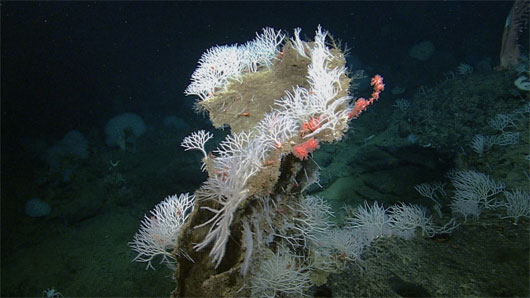Discovered four new carnivorous sponges
The carnivorous sponges often live and grow in the deep sea floor. For the first time, scientists discovered some carnivorous sponges about 20 years ago.
Recently, biologist Lonny Lundsten, Monterey Bay Aquarium Research Institute (MBARI) in California, USA, and two Canadian colleagues discovered and described four new carnivorous sponges living on the sea floor. deep, from the Pacific Northwest to Baja California state.
This creature is shaped like bare branches of small bushes, surrounded by small hairs that bind together to form a trap to catch prey. Their food is small crustaceans such as shrimp and crab.
When the bait is caught, the sponge cells begin to slowly digest the animal. After several days, the prey is just an empty shell.
MBARI researchers recorded new sponges in the deep sea and collected samples. Sponges for food consumption are bacteria and single-celled organisms that swim in the water through an organ that acts as a filter.
At a depth of thousands of meters below the sea floor, finding such food is indeed very difficult, so they often hunt prey as large, nutrient-rich creatures, such as crustaceans.

This sponge of the genus Asbestopluma , was first discovered and sampled from Davidson underground mountain, a volcano that has been deactivated, located deep in the central California.
The second new species is called Asbestopluma rickettsi , named after marine biologist Ed Ricketts. Scientists have discovered and conducted this observation of sponges at two locations in the waters off Southern California.
At one point, they observed that sponges that live in the environment together with mussels and pipeworms, the food of this species is the bacteria that absorb nutrients from methane gas escaping from the sea floor.
Although A. rickettsi's body has many spines, during the observation of the collected specimens, the researchers found no trace of trapped prey. Research has shown that chemosynthetic organisms are the main source of their food is bacteria.
The recently discovered Cladorhiza caillieti was discovered in a lava flow along the volcanic slope of Juan de Fuca Ridge, off Vancouver Island.
Another species, Cladorhiza evae , was discovered in the southern sea, in the Rise Alarcon hydrothermal vents, off the Baja California peninsula.
Observing the specimens of two sponges: Cladorhiza caillieti and Cladorhiza evae, the scientists discovered that there were many prey trapped between their spines.
Although it is clear that the specimens showed that sponges often hunt and consume crustaceans trapped in their special traps, researchers still hope they can. Observe this image practically in nature.
So far, in the Northeast Pacific, more carnivorous sponges have been found and collected specimens for scientific research.
- Video: Detecting a harp-like sponge
- Discover scary carnivorous plants in Canada
- Sponges in New Zealand
- Detecting new carnivorous plants
- New fossil carnivorous dinosaurs discovered in South America
- Discovered a new giant carnivorous dinosaur that once existed in Africa
- Extremely hidden carnivorous plants
- Discovered new carnivorous dinosaurs who once lived in the desert
- Whether or not Man-Eating Tree?
- Sponges have up to 70% of human genes
- Discovered new carnivorous plants in Japan
- Beach covered with white foam like snow mats
 Surprised: Fish that live in the dark ocean still see colors
Surprised: Fish that live in the dark ocean still see colors Japan suddenly caught the creature that caused the earthquake in the legend
Japan suddenly caught the creature that caused the earthquake in the legend A series of gray whale carcasses washed ashore on California's coast
A series of gray whale carcasses washed ashore on California's coast Compare the size of shark species in the world
Compare the size of shark species in the world